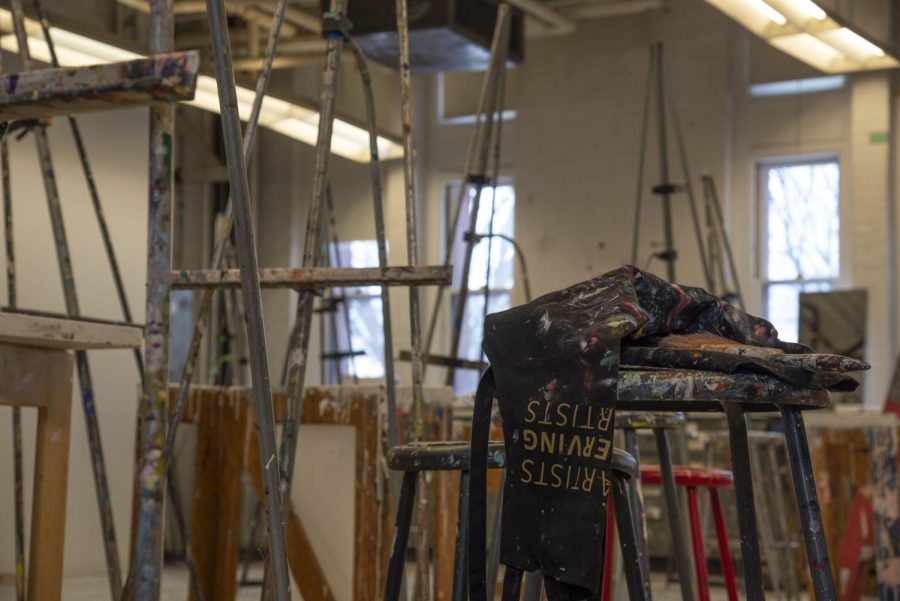Faculty Senate approves proposed School of the Arts within CAS
An apron sits on a stool in an art classroom in Williams Hall Jan. 25.
UVM’s Faculty Senate approved the proposed School of the Arts, an interdisciplinary program within the College of Arts and Sciences as a part of academic reorganization efforts, at a Jan. 24 meeting.
If passed by all necessary voting bodies, the departments of art and art history, theater and dance, and music will merge to make up the proposed SOTA, according to the proposal for the school. The board of trustees will vote on the proposal on Feb. 4.
Before getting to the Faculty Senate, arts faculty endorsed the proposal and CAS faculty voted on it, according to a Jan. 30 email from Dean of CAS Bill Falls.
The change is entirely administrative and it will have no impact on the majors or the minors in the current departments, said Stephen Everse, co-chair of the curricular affairs committee, an academic planning committee within the Faculty Senate.
“The courses are not changing, the faculty are not changing,” Falls said. “This is an administrative reorganization that we actually think is going to have significant benefits for students studying in the arts.”
Once approved, the jobs of department chairs will be replaced by program director positions within each discipline in the SOTA, said Pamela Fraser, interim chair of the department of art and art history. The people currently holding chair positions will see slight changes in their responsibilities and rejoin United Academics, UVM’s faculty union.
The chairs of the three departments were not eligible to be a part of the union in their current positions because they are directly in charge of evaluating faculty and oversee faculty who are in the union, Fraser said.
The program directors will see a decrease in the compensation they received as department chairs, because a portion of their current roles will be taken up by whoever becomes Director of the SOTA, though the exact stipend change has yet to be established, according to a Jan. 26 email from Fraser.
As program directors, those who are currently chairs will still be in charge of scheduling, purchases, talking with students and the other aspects of running a department, while the SOTA Director will handle personnel management, Fraser said.
Fraser and other faculty are working on creating a course called “Looking and Learning,” which will be taught by a studio art or art history professor, a music professor and a theater and dance professor, Fraser said. She hopes there will be more collaborative classes in the future.
When the departments combine into one main school within CAS, Fraser hopes the programs will become more collaborative with each other, she said.
The SOTA models other universities that created similar programs, according to the proposal. Some of these universities include the University of Connecticut, University of Maine, Boston University and 45 others.
Bringing the departments together in one larger school encourages faculty to broaden their view of their discipline and mingle more with faculty from other disciplines, ultimately enhancing collaboration, Falls said.
“There are people who have been more than 10 years in the arts and didn’t know each other,” Falls said.
The University aims to appoint an overarching Director of the SOTA by mid-March, Falls said. An Associate Director will also be appointed, according to the SOTA proposal.
Additionally, Falls and Patricia Prelock, provost and senior vice president, are contributing $50,000 of discretionary funding to get the SOTA off the ground, Everse said.
Not many students are aware of the change yet because it will not impact their majors and doesn’t have any immediate implications for their lives, said David Neiweem, interim chair for the department of music.
“My adviser mentioned two days ago that they’re making the School of the Arts, that’s all I know,” said junior Jessie McCarthy, a music technology and business major.
McCarthy also said she struggled to understand how it would benefit students to merge the three distinct departments.
“Instead of actually creating a new program for us and our needs and providing for us individually, it’s really just […] making us a less important piece of the college,” she said.
McCarthy worries this attempt at promoting collaboration will turn the departments into faceless members within the SOTA, which would lessen their perceived importance, she said.
Junior Kyra Gillespie, a theater major and dance minor, thinks administration should have held a meeting with the students from the affected departments before enacting the changes, she said.
Still, Gillespie thinks the collaboration between faculty would diversify their own learning which would carry over into the students’ learning as well as creating more connections for students, she said.
The University has not announced the change to students in the affected departments because it would precede a decision that has yet to be approved, Falls said. Once the board of trustees approves the change, faculty will discuss communicating changes to students in impacted majors.











